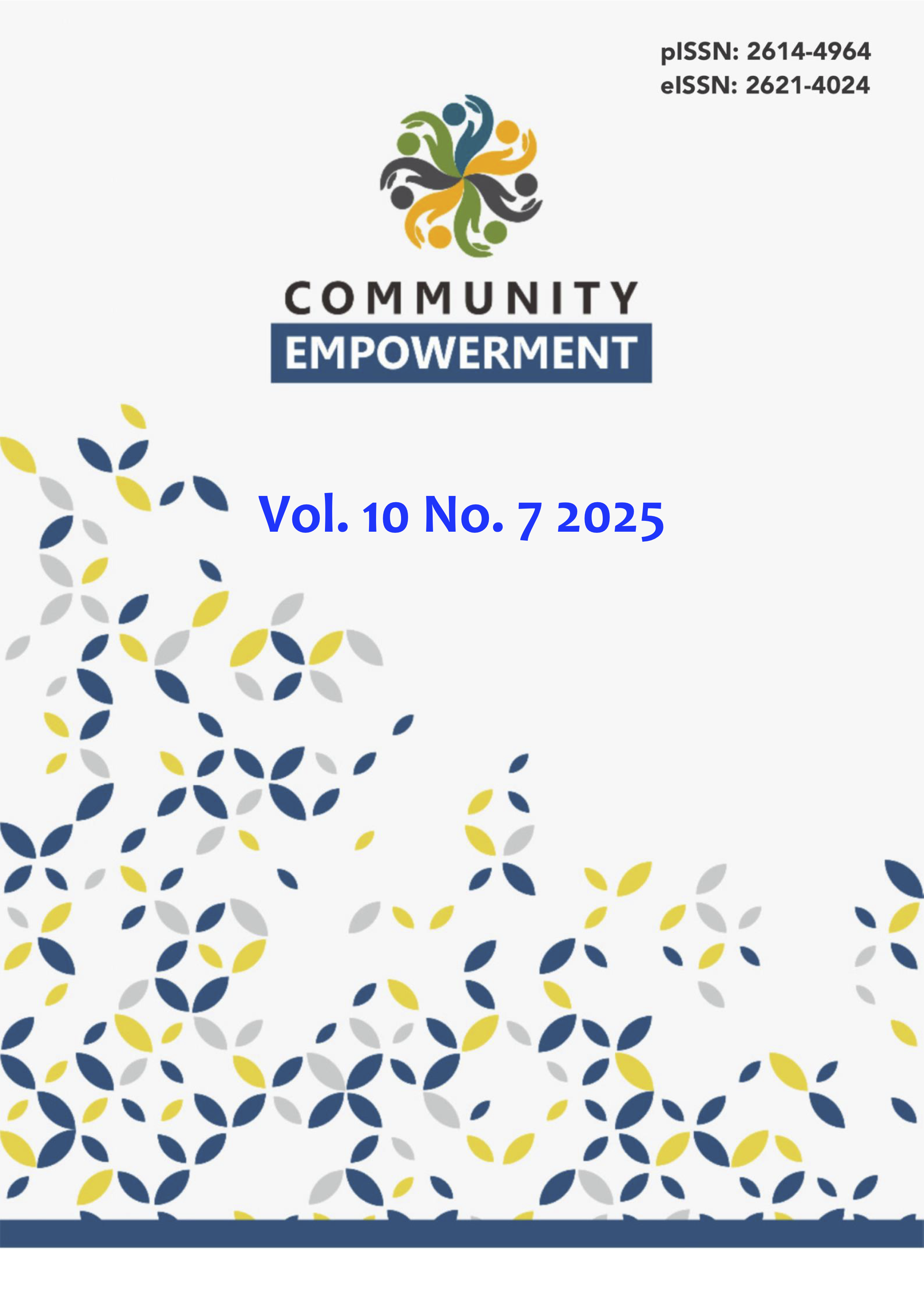Main Article Content
Abstract
Dukun Subdistrict is one of the areas with a high level of vulnerability to Mount Merapi eruptions. The low understanding of technical disaster mitigation terms among rural communities, particularly those in the KRB III (Third Zone of Disaster-Prone Area), served as the foundation for implementing the "Layar Merapi" program. This community service initiative utilizes open-air cinema screenings, combined with educational sessions and performances of local cultural arts, to foster disaster preparedness. The program was conducted in six villages, employing an educational, participatory, and culture-based approach. The results indicate that this initiative successfully increased the community's collective understanding of disaster mitigation and strengthened social networks among village residents.
Keywords
Article Details

This work is licensed under a Creative Commons Attribution-NonCommercial 4.0 International License.
References
- Arifianto, B. D., & Muktaf, Z. M. (2019). Open Air Cinema Sebagai Ruang Komunikasi. Jurnal Publisitas, 6(1), 39–49. https://doi.org/10.17605/OSF.IO/4TGJA
- Astari, D., Banggur, W. F., Santi, N., & Najib, N. (2022). Pemetaan Zona Bahaya Aliran Piroklastik Gunung Merapi, Jawa Tengah dan Sekitarnya menggunakan Aplikasi Titan 2D. Jurnal Geosains Dan Teknologi, 5(1), 76–82. https://doi.org/10.14710/jgt.5.1.2022.76-82
- Beggs, J. C. (2018). Applications: Disaster Communication and Community Engagement. Disaster Epidemology, 163–169. https://doi.org/10.1016/B978-0-12-809318-4.00022-8
- Gisevius, K., Niesters, L. M., & Braun, B. (2025). The role of community leadership in building community adaptive capacity to coastal hazards–Insights from neighborhood networks in Semarang, Indonesia. Environmental Science & Policy, 163(2), 103963. https://doi.org/10.1016/j.envsci.2024.103963
- Gumono, G., Sarwono, S., Yulistio, D., Pitawan, K. A., Solihin, M., & Julianto, E. (2022). Development of local wisdom-based thematic teaching materials to improve adaptive cultural literacy. Community Empowerment, 7(6), 978–987. https://doi.org/10.31603/ce.6560
- Hanifa, L., Azaluddin, A., Arjuwita, A., Karlina, A. R., & Riskawat, R. (2021). Community empowerment through a social capital approach in the development of tourism destination in Wawoangi Village. Community Empowerment, 6(6), 1029–1036. https://doi.org/10.31603/ce.4917
- Hicks, A., Armijos, M. T., Barclay, J., Stone, J., Robertson, R., & Cortés, G. P. (2017). Risk communication films: Process, product and potential for improving preparedness and behaviour change. International Journal of Disaster Risk Reduction, 23, 138–151. https://doi.org/10.1016/j.ijdrr.2017.04.015
- Hutagalung, R., Permana, A. P., Uno, D. A. N., Fauzan, M. N. Al, & Panai, A. A. H. (2022). Upaya Peningkatan Pengetahuan Siswa Tentang Pentingnya Mitigasi Bencana di Desa Hutamonu, Kecamatan Botumoito, Kabupaten Boalemo. LAMAHU Jurnal Pengabdian Masyarakat Terintegrasi, 1(2), 96–100. https://doi.org/10.34312/ljpmt.v1i2.15660
- Kodaş, B. (2023). Promoting Events and Festivals Through Digital Marketing Tools: A Conceptual Framework. In Event Tourism and Sustainable Community Development (pp. 129–140). Apple Academic Press.
- Kusuma, A., Saputri, A. A., Ayuningtyas, J. I., Susanti, D., Sandy, F., & Suryaningtyas, A. A. (2025). Merapi ceria alert: Early childhood education in disaster-prone areas of Mount Merapi. Community Empowerment, 10(1). https://doi.org/10.31603/ce.12953
- Lu, X., & Lo, H.-P. (2007). Television audience satisfaction: Antecedents and consequences. Journal of Advertising Research, 47(3), 354–363. https://doi.org/10.2501/S0021849907070365
- Manulang, W., Haifaturrahmah, Wang, L., Syaharuddin, S., & Al‐Adawi, S. (2024). The Audio-Visual Media on Cognitive Learning Outcomes. Jurnal Ilmiah Sekolah Dasar, 7(4), 641–648. https://doi.org/10.23887/jisd.v7i4.61138
- Meilasari-Sugiana, A., & Endro, G. (2019). Shaping collective action for community-based disaster management in Merapi, Central Java, Indonesia. Journal of Emergency Management, 17(5), 385–401. https://doi.org/10.5055/jem.2019.0410
- Mubarak, A. F., Amiruddin, R., & Gaus, S. (2019). The effectiveness of disaster prevention and mitigation training for the students in disaster prone areas. IOP Conference Series: Earth and Environmental Science, 235(1). https://doi.org/10.1088/1755-1315/235/1/012055
- Nazaruddin, M. (2022). The role of natural disasters in the semiotic transformations of culture: the case of the volcanic eruptions of Mt. Merapi, Indonesia. Semiotica, 2022(246), 185–209. https://doi.org/10.1515/sem-2021-0043
- Oktradiksa, A., Haq, A. L. A., & Imaduddin, H. (2023). Empowerment of MIM Surodadi 1, Magelang Regency to create disaster resilient schools. Community Empowerment, 8(12), 2088–2093. https://doi.org/10.31603/ce.10395
- Ramrakhiyani, J. (2022). Media and Communication in Disaster Risk Reduction. In International Handbook of Disaster Research (pp. 1389–1398). International Handbook of Disaster Research. https://doi.org/10.1007/978-981-16-8800-3_89-1
- Rivetti, F., & Rossi, C. (2020). Co-Creating a Cultural Mega-Event: When and how do Local Residents get Engaged? ICTR20-Proceedings of the 3rd International Conference on Tourism ResearchVolume: ICTR20-Proceedings of the 3rd International Conference on Tourism Research.
- Rizki, I. A., Bintoro, H., Nisa, K., Rahman, P., Realita, A., & Deta, U. A. (2021). Profile of Community Understanding and Literacy About Disaster Risk Mitigation: The Responses of Java South Coast Community Against Megathrust Earthquake and Tsunami Prediction. 7(3), 294–308. https://doi.org/10.20961/GE.V7I3.52902
- Rizzello, K. (2014). Misurazione dell’impatto sociale degli eventi culturali a fini turistici. Due casi di studio a confronto. Rivista Geografica Italiana, 121(1), 61–80.
- Rossouw, M. P. (2025). On constraints: How ‘less is more’(in [teaching with] short films). Short Film Studies, 15(1), 7–15. https://doi.org/10.1386/sfs_00130_1
- Sumbogo, T. A., & Mutmainnah, N. (2022). Filmmaking and Critical Pedagogy Amongst Youth as Cultural Empowerment in Banyumas, Indonesia. Ikat: The Indonesian Journal of Southeast Asian Studies, 5(2), 113. https://doi.org/10.22146/ikat.v5i2.71556
- Troll, V. R., Deegan, F. M., & Seraphine, N. (2024). Employing ancient oral traditions in Central Java to warn of volcano–earthquake interaction. European Geosciences Union General Assembly 2024 (EGU24). https://doi.org/10.5194/egusphere-egu24-5663
- Utami, C. D., Wardhana, A. P. S., Setiawan, A. H., & Pratmajaya, P. (2023). Pelatihan penyelenggaraan projek penguatan profil pelajar pancasila di SDN Ketelan 12 Surakarta. E-Dimas: Jurnal Pengabdian Kepada Masyarakat, 14(4), 693–701. https://doi.org/10.26877/e-dimas.v14i4.13919
- Wu, G., Hu, Z., Wang, H., & Liu, B. (2024). Adding sectors or strengthening ties? Adaptive strategies for cross-sector collaboration in disaster governance. Public Management Review, 1–23. https://doi.org/10.1080/14719037.2024.2315563

